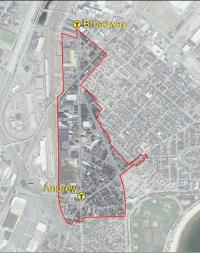December 23, 2015
 A map illustrates the dimensions of an ongoing Boston Redevelopment Authority planning process focused on the Dorchester Avenue corridor between Andrew and Broadway MBTA stations. BRA image
A map illustrates the dimensions of an ongoing Boston Redevelopment Authority planning process focused on the Dorchester Avenue corridor between Andrew and Broadway MBTA stations. BRA image
South Boston business owners impacted by the South Boston Dorchester Avenue corridor rezoning project listened to and queried city officials at a meeting last Monday night, asking for assurance that their normal operations would not be overhauled by a change in the area’s character.
Since July, the Boston Redevelopment Authority (BRA) has engaged with the community about the 122 acre study area, which stretches from Broadway to Andrew station. The segment is “experiencing market pressures to change from its traditional manufacturing and industrial uses to residential and mixed-use,” according to BRA documentation.
Officials and community members hope to see the expanse of light industrial space transformed into a mix of retail spaces and apartment buildings, speckled with open green space and new roads.
The Dec. 14 meeting at the Marr Building on D Street immediately preceded the South Boston Dot Ave growth district monthly community meeting. Mayor Martin Walsh’s chief of economic development, John Barros, addressed the business owners packed into a conference room.
“This is not about telling you what you’re going to do with your business,” Barros said. “The city will not use any powers to remove anyone.”
He emphasized that the discussion surrounding the study site would hopefully be to the benefit of existing businesses, because the first priority is to ensure the jobs provided by those business remain in Boston.
Given a chance to assess the impact on their livelihoods, several business owners pointed out that they were essentially operating 24 hours a day, during which they had permits to enact their work at unusual hours. They worried that new residents to the areas would try to put pressure on manufacturing businesses that do not conform to their expectations of the area.
Bob Gibson, of Old Town Trolley of Boston, said the cranes his business uses are noisy, and operate at early hours. Gibson wondered if his nearest neighbor was instead “a seven-story high rise, a million [dollars} plus per condo, and I fire up; who’s going to put up with that?”
“This is not to sacrifice jobs and businesses to create residential units,” Barros said. He later promised that the city would never forbid permit usage. “It’s just not in the City’s interest to choke you out of business,” he said.
Months of walking tours, community meetings, and land-use exercises brought the BRA to a few potential zoning designs. Stretches of proposed buildings could reach up to 300 feet high, but the tallest are currently expected to rise nearer to the Southeast Expressway and the train tracks. More cohesive 50 foot structures are proposed near Dorchester and Preble streets.
Discussions surrounding the planning and rezoning of the South Boston stretch are expected to continue into Spring 2016. Officials characterized the meetings as in early stages.
Barros said after the meeting that they planned to convene more sessions directed toward business owners specifically. After the South Boston zoning project is completed, Barros said the City is looking at other neighborhoods for possible reassessment, but declined to provide further details.


